Why won’t lawn mower start is a common frustration for homeowners. At WHY.EDU.VN, we understand the annoyance of a lawn mower that refuses to start, especially when you’re eager to get your lawn looking its best. This comprehensive guide will walk you through common causes and easy fixes, helping you diagnose the problem and get your machine running smoothly. We’ll cover everything from fuel issues to spark plugs, ensuring you have the knowledge to tackle the job.
1. Fuel Problems: The Prime Suspect
One of the most frequent reasons your lawn mower refuses to start revolves around fuel. Ensuring your fuel system is in top shape is paramount.
1.1. Stale Fuel: A Common Culprit
Old gas can lose its combustibility, becoming a leading cause of starting failures.
- The Problem: Gasoline older than 30 days can degrade, losing its ability to ignite properly.
- The Solution: Always use fresh fuel. If your gas is old, drain the tank using a siphon pump and dispose of it properly. Refill with fresh gasoline.
1.2. Contaminated Fuel: Water and Debris
Contaminants in your fuel can severely impact your lawn mower’s ability to start.
- The Problem: Water or debris in the fuel tank can prevent the engine from igniting.
- The Solution: Drain the fuel tank completely. Inspect for any visible contaminants. Clean the tank if necessary and refill with fresh, clean gasoline.
1.3. Fuel Cap Vent: Ensuring Proper Flow
A blocked fuel cap vent can create a vacuum, hindering fuel flow.
- The Problem: A clogged vent in the fuel cap prevents air from entering the tank, creating a vacuum that stops fuel flow.
- The Solution: Remove the fuel cap to break the vacuum. If the mower starts, the cap is the issue. Clean or replace the fuel cap.
2. Clogged Mower Deck: Clearing the Path
A clogged mower deck obstructs the blade’s movement, adding stress to the engine.
2.1. Grass Clippings Buildup: The Obstruction
Accumulated grass clippings can restrict the blade, making starting difficult.
- The Problem: Grass clippings can clog the mower deck, preventing the blade from turning freely.
- The Solution: Turn off the mower and disconnect the spark plug. Tip the mower on its side and scrape away any accumulated grass clippings. Clean the deck thoroughly.
3. Air Filter Issues: Breathing Easy
The air filter ensures clean air reaches the engine. A dirty filter starves the engine.
3.1. Dirty Air Filter: Restricted Airflow
A clogged air filter can prevent the engine from receiving enough air.
- The Problem: A dirty air filter restricts airflow to the engine, causing it to struggle or fail to start.
- The Solution: Inspect the air filter. If it’s dirty, replace it or clean it (if it’s a foam filter). Ensure the filter is dry before reinstalling.
4. Spark Plug Problems: Igniting the Engine
The spark plug is crucial for igniting the fuel-air mixture.
4.1. Faulty Spark Plug: No Ignition
A bad spark plug won’t create the necessary spark to start the engine.
- The Problem: A fouled or damaged spark plug prevents the engine from igniting.
- The Solution: Remove the spark plug and inspect it. Clean it with a wire brush if it’s dirty, or replace it if it’s damaged. Ensure the gap is correct before reinstalling.
4.2. Disconnected Spark Plug Wire: Losing Connection
A loose spark plug wire interrupts the ignition process.
- The Problem: A disconnected or loose spark plug wire prevents the spark from reaching the engine.
- The Solution: Ensure the spark plug wire is securely connected to the spark plug. Replace the wire if it’s damaged.
5. Fuel Filter Blockage: Fuel Delivery
A clogged fuel filter restricts fuel flow, hindering the engine’s operation.
5.1. Clogged Fuel Filter: Restricted Flow
A blocked fuel filter starves the engine of fuel.
- The Problem: A clogged fuel filter restricts fuel flow to the engine, causing it to stall or not start.
- The Solution: Locate the fuel filter and inspect it. If it’s clogged, replace it. Ensure the fuel lines are clear of any obstructions.
6. Safety Mechanisms: Ensuring Safe Operation
Safety features prevent accidental starts.
6.1. Safety Release Mechanism Cable: Ensuring Connection
A malfunctioning safety cable can prevent starting.
- The Problem: A damaged or improperly adjusted safety cable can prevent the engine from starting.
- The Solution: Inspect the safety cable for any damage or binding. Ensure it moves freely and is properly connected. Replace the cable if necessary.
6.2. Flywheel Brake: Disengaging Properly
A stuck flywheel brake can prevent the engine from turning over.
- The Problem: A fully engaged flywheel brake can prevent the engine from starting.
- The Solution: Check the brake pad to ensure it’s not making full contact with the flywheel. Ensure the control lever can move freely.
7. Oil Levels: Engine Health
Proper oil levels are crucial for engine lubrication and performance.
7.1. Low Oil Level: Insufficient Lubrication
Insufficient oil can prevent the engine from starting.
- The Problem: Low oil levels can cause increased friction and prevent the engine from starting.
- The Solution: Check the oil level and add oil as needed. Use the correct type of oil as specified in your mower’s manual.
7.2. Old Oil: Degraded Lubrication
Old oil can lose its lubricating properties.
- The Problem: Old oil can break down and lose its lubricating properties, making starting more difficult.
- The Solution: Change the oil regularly as recommended in your mower’s manual.
8. Uncommon Issues: Digging Deeper
Explore less common reasons your lawn mower might not start.
8.1. Ignition Switch Malfunction: No Contact
A faulty ignition switch can prevent the engine from starting.
- The Problem: The ignition switch may be faulty or not making proper contact.
- The Solution: Test the ignition switch for continuity. Replace the switch if it’s faulty.
8.2. Water in the Fuel Line: Blocking Combustion
Water in the fuel line prevents combustion.
- The Problem: Water in the fuel line can prevent the fuel from combusting during the starting process.
- The Solution: Drain the fuel line and tank to remove any water. Refill with fresh, clean gasoline.
8.3. Incorrect Choke Adjustment: Fuel-Air Mixture
Improper choke adjustment affects the fuel-air mixture.
- The Problem: Incorrectly adjusting the choke can lead to either too much or too little fuel mixing with air in the engine, preventing it from starting.
- The Solution: Adjust the choke according to the manufacturer’s instructions.
9. When to Call a Professional: Seeking Expert Help
Recognize when professional help is needed for lawn mower repairs.
9.1. Black Smoke: Engine Trouble
Black smoke indicates serious engine issues.
- The Problem: Black smoke indicates a cracked engine or other significant wear.
- The Solution: Consult a professional technician for an evaluation and repair.
9.2. Excessive Oil or Gas Usage: Inefficiency
High consumption of oil or gas signals underlying problems.
- The Problem: Excessive oil or gas consumption indicates internal engine issues.
- The Solution: Seek professional help for a thorough inspection and repair.
9.3. Knocking Sounds: Internal Damage
Knocking sounds suggest internal components are damaged.
- The Problem: A knocking sound indicates that something could be bent or out of alignment.
- The Solution: Contact a professional to diagnose and repair the issue.
9.4. Vibrating or Shaking: Alignment Issues
Excessive vibration suggests mechanical problems.
- The Problem: A vibrating or shaking lawn mower can be a sign of a problem beyond a DIY fix.
- The Solution: Consult a professional for an evaluation and repair.
10. Lawn Mower Maintenance Tips: Preventing Future Problems
Preventative care can help keep your mower running smoothly.
10.1. Regular Cleaning: Keeping It Tidy
Regular cleaning prevents buildup and clogs.
- Tip: Clean the mower deck and engine regularly to prevent buildup of grass and debris.
10.2. Proper Storage: Protecting Your Investment
Proper storage prolongs the life of your mower.
- Tip: Store your lawn mower in a dry, sheltered place during the off-season.
10.3. Timely Oil Changes: Maintaining Lubrication
Regular oil changes keep the engine running smoothly.
- Tip: Change the oil regularly as recommended in your mower’s manual.
10.4. Fresh Fuel: Ensuring Combustibility
Using fresh fuel ensures optimal performance.
- Tip: Always use fresh fuel and stabilize it if the mower will be stored for an extended period.
10.5. Sharpening Blades: Enhancing Performance
Sharp blades improve cutting efficiency.
- Tip: Sharpen or replace the blades regularly to ensure a clean and efficient cut.
11. Understanding Lawn Mower Engines: A Technical Overview
Gain insight into how lawn mower engines function.
11.1. Two-Stroke Engines: Simplicity and Power
Two-stroke engines are known for their simplicity.
- Description: Two-stroke engines combine the intake, compression, combustion, and exhaust strokes into two movements.
- Maintenance: Requires mixing oil with gasoline.
11.2. Four-Stroke Engines: Efficiency and Longevity
Four-stroke engines offer improved efficiency.
- Description: Four-stroke engines complete the combustion cycle in four separate strokes: intake, compression, combustion, and exhaust.
- Maintenance: Requires separate oil reservoir.
12. Common Lawn Mower Brands and Their Specific Issues
Specific brands may have unique issues.
12.1. Honda: Reliability with Fuel Concerns
Honda mowers are known for reliability.
- Common Issue: Fuel-related issues due to carburetor clogging.
- Solution: Regular carburetor cleaning and fuel stabilizer use.
12.2. Toro: Innovation with Safety Checks
Toro mowers are known for innovation.
- Common Issue: Safety interlock malfunctions.
- Solution: Check and maintain safety cables and switches.
12.3. Craftsman: Versatility with Spark Problems
Craftsman mowers are known for versatility.
- Common Issue: Spark plug failures.
- Solution: Regular spark plug inspections and replacements.
13. Troubleshooting Chart: Quick Reference Guide
Use this chart for quick problem identification.
| Problem | Possible Cause | Solution |
|---|---|---|
| Won’t start | Stale fuel | Drain and replace with fresh fuel |
| Won’t start | Clogged air filter | Clean or replace air filter |
| Won’t start | Faulty spark plug | Clean or replace spark plug |
| Shuts off after a few minutes | Clogged fuel cap vent | Clean or replace fuel cap |
| Hard to pull cord | Clogged mower deck | Clean mower deck |
| No power | Clogged fuel filter | Replace fuel filter |
| Engine knocking | Internal engine damage | Consult a professional |
| Vibrating excessively | Loose or misaligned components | Consult a professional |

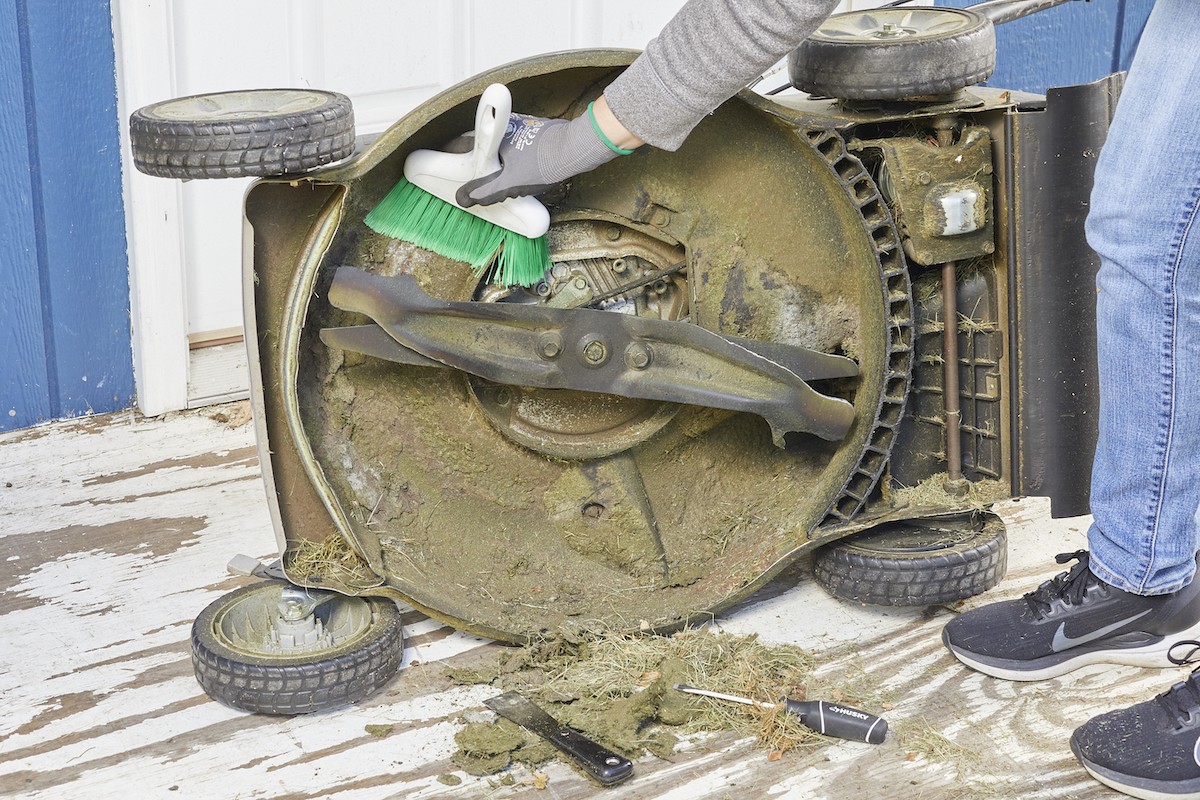
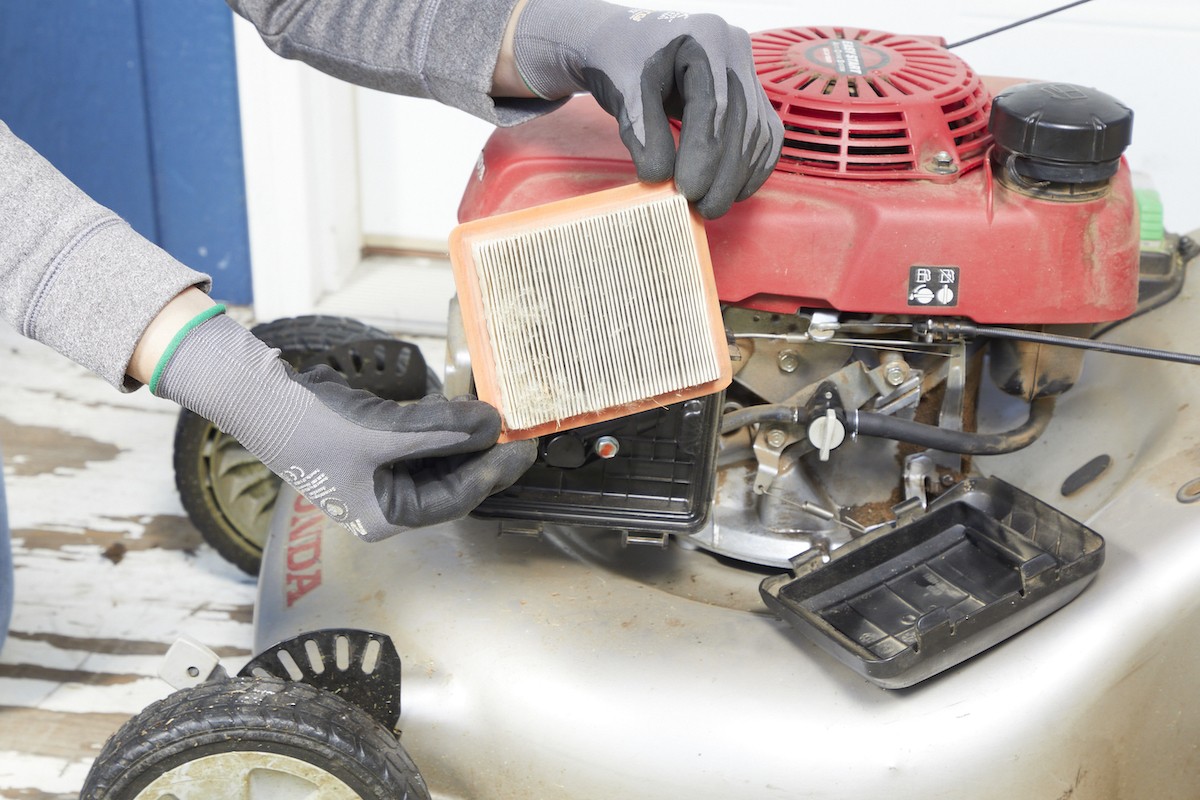

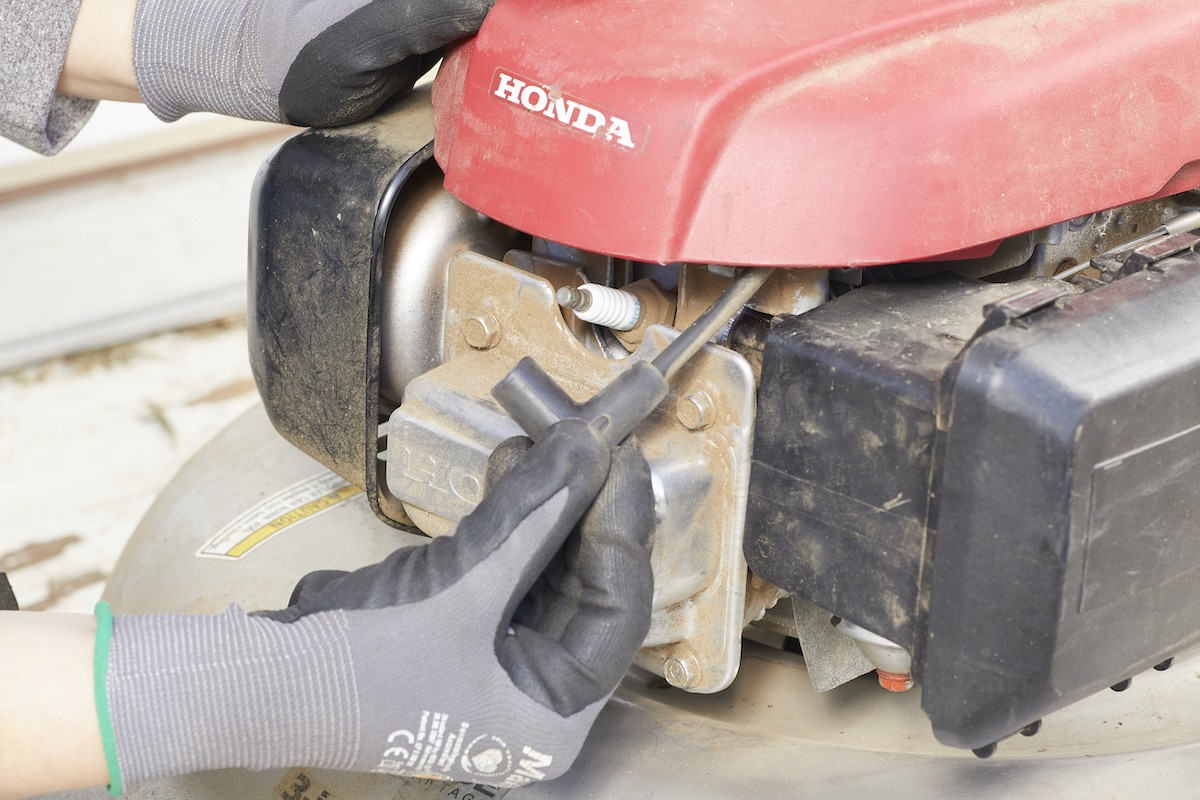
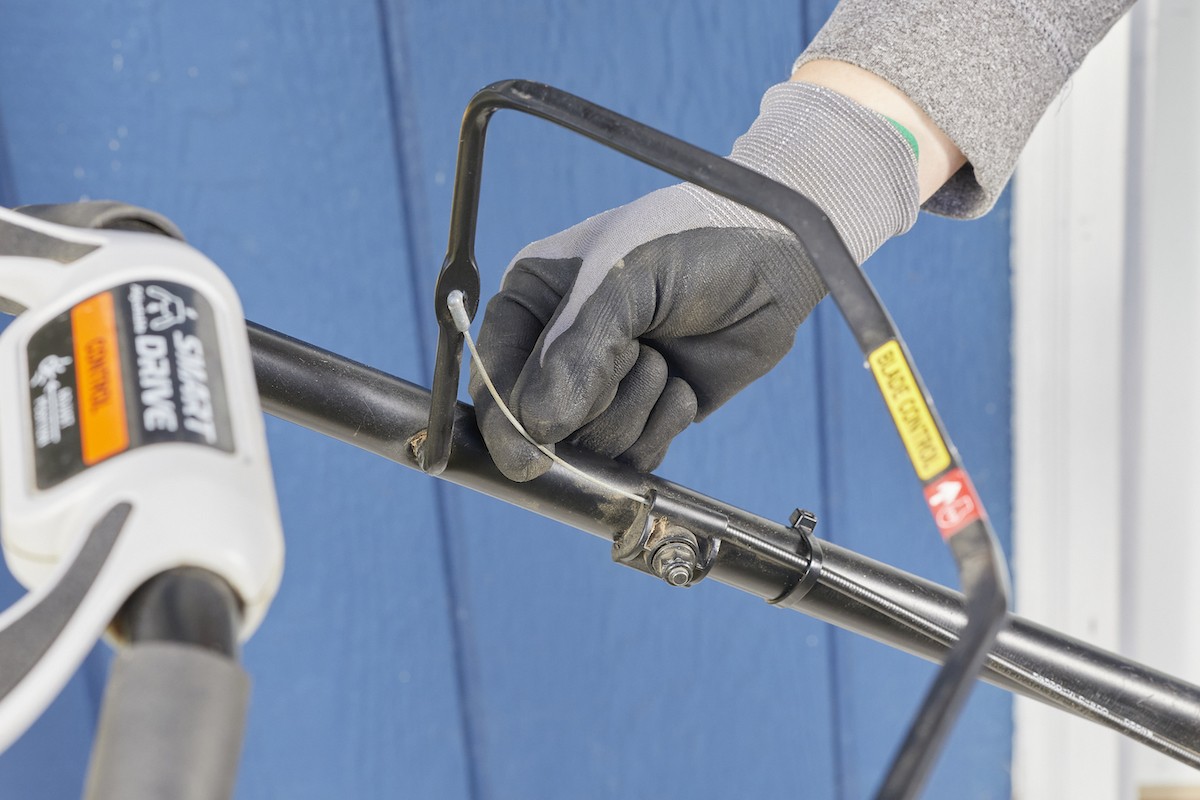
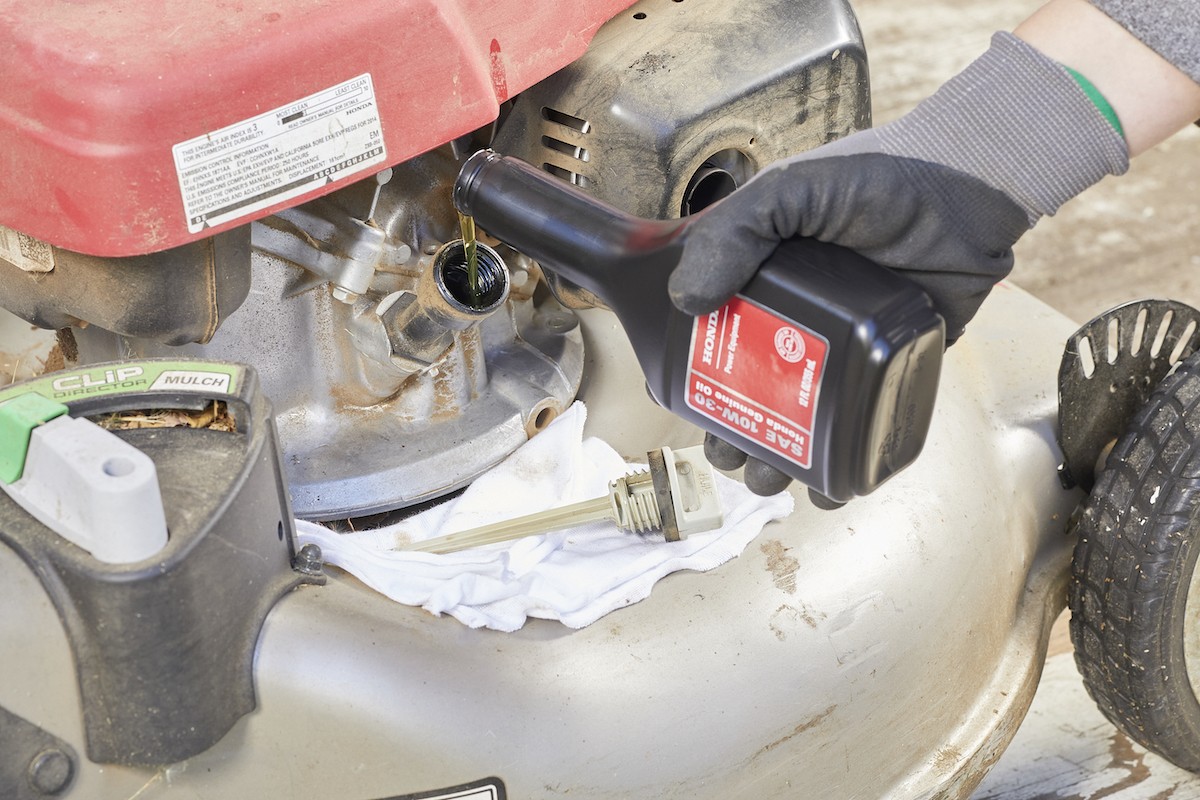
14. Seasonal Lawn Mower Care: Preparing for Each Season
Different seasons require different maintenance routines.
14.1. Spring Prep: Getting Ready to Mow
Spring preparation sets the stage for the mowing season.
- Tasks: Change oil, replace spark plug, sharpen blades, and check all fluids.
14.2. Summer Maintenance: Keeping It Running
Summer maintenance ensures continued performance.
- Tasks: Regularly clean the mower deck, check air filter, and monitor oil levels.
14.3. Fall Shutdown: Preparing for Winter
Fall shutdown protects the mower during winter storage.
- Tasks: Drain fuel, stabilize fuel system, clean thoroughly, and store in a dry place.
15. Environmental Considerations: Eco-Friendly Lawn Care
Adopt eco-friendly practices for lawn care.
15.1. Electric Mowers: Reducing Emissions
Electric mowers offer a cleaner alternative.
- Benefits: Zero emissions, quieter operation, and reduced maintenance.
15.2. Proper Disposal of Waste: Eco-Consciousness
Proper disposal protects the environment.
- Guidelines: Recycle old oil and parts, and dispose of gasoline responsibly.
16. The Role of the Carburetor: Understanding Fuel-Air Mixture
The carburetor mixes fuel and air for combustion.
16.1. Carburetor Function: Mixing Fuel and Air
The carburetor is essential for engine performance.
- Explanation: The carburetor mixes fuel and air in the correct proportions to create a combustible mixture.
- Maintenance: Regular cleaning to prevent clogs and ensure proper mixture.
16.2. Cleaning the Carburetor: Removing Blockages
Cleaning ensures the carburetor functions properly.
- Steps: Disassemble the carburetor, clean each component with carburetor cleaner, and reassemble.
17. Tools and Equipment: Essential DIY Gear
Gather the necessary tools for lawn mower maintenance.
17.1. Basic Tools: Starting Your Toolkit
Essential tools include wrenches, screwdrivers, and pliers.
- List: Socket set, screwdrivers, pliers, wire brush, and oil drain pan.
17.2. Advanced Tools: Tackling Complex Repairs
Advanced tools facilitate more complex repairs.
- List: Compression tester, multimeter, and carburetor cleaning kit.
18. Starting Difficulties with Different Types of Lawnmowers
Explore common starting issues specific to different types of lawnmowers.
18.1. Push Mowers: Typical Issues and Solutions
Push mowers, also known as walk-behind mowers, are a staple for many homeowners due to their simplicity and ease of use. However, they can still encounter starting problems. Common issues include stale fuel, a dirty air filter, or a faulty spark plug. Ensuring fresh fuel, cleaning or replacing the air filter, and checking the spark plug are often the first steps in resolving these issues. Additionally, a clogged mower deck can impede the blade’s movement, making it harder to start. Regular cleaning and maintenance can prevent these problems.
18.2. Self-Propelled Mowers: Unique Challenges
Self-propelled mowers add an extra layer of convenience by providing powered assistance to move forward. However, this additional mechanism can introduce unique challenges. In addition to the common issues with push mowers, self-propelled mowers may have problems with the drive system. Issues like a loose or broken drive belt, a malfunctioning drive cable, or worn-out gears can prevent the mower from starting or moving properly. Inspecting and maintaining these components are essential for keeping self-propelled mowers in good working condition.
18.3. Riding Mowers: Complex Systems and Starting Issues
Riding mowers, designed for larger lawns, feature more complex systems than push or self-propelled models. Starting issues can stem from a variety of sources. Besides the usual suspects like fuel and spark plugs, riding mowers often have safety switches that can malfunction. These switches are designed to prevent the mower from starting if the operator is not in the seat or if the parking brake is not engaged. A faulty ignition switch, a dead battery, or a malfunctioning solenoid can also prevent the mower from starting. Regular battery maintenance, checking the safety switches, and ensuring the ignition system is in good condition are crucial for maintaining a riding mower.
18.4. Zero-Turn Mowers: High Performance, High Maintenance
Zero-turn mowers offer exceptional maneuverability and speed, making them ideal for large, complex lawns. However, their advanced design also means they require more maintenance. In addition to the issues faced by other types of mowers, zero-turn models can have hydraulic system problems. The hydraulic system controls the mower’s drive and steering, and issues like leaks, low fluid levels, or a faulty pump can prevent the mower from starting or operating correctly. Regularly inspecting the hydraulic system, maintaining fluid levels, and addressing any leaks promptly are essential for keeping a zero-turn mower running smoothly.
19. Lawn Mower Starting Problems: A Deep Dive Into Potential Causes
Let’s explore each potential cause for why your lawnmower won’t start in more detail.
19.1. Spark Plug Troubleshooting and Solutions
The spark plug is a crucial component in your lawnmower’s engine, responsible for igniting the air-fuel mixture. A faulty spark plug can be a primary reason your mower won’t start.
Common Spark Plug Issues:
- Fouled Spark Plug: Carbon buildup can prevent the spark plug from firing correctly.
- Cracked or Damaged Insulator: Visible cracks can cause the spark to ground out.
- Incorrect Gap: The gap between the electrodes must be precise for optimal ignition.
- Loose Connection: A loose spark plug wire can interrupt the ignition process.
Troubleshooting Steps:
- Visual Inspection: Remove the spark plug and inspect it for carbon buildup, cracks, or damage.
- Cleaning the Spark Plug: Use a wire brush to gently clean carbon deposits from the electrode.
- Checking the Gap: Use a spark plug gap tool to ensure the gap meets the manufacturer’s specifications.
- Testing for Spark: Attach the spark plug wire, ground the plug against the engine, and pull the starter cord to check for a visible spark.
Solutions:
- Cleaning: If the spark plug is fouled, clean it thoroughly.
- Replacing: If the spark plug is cracked or damaged, replace it with a new one.
- Adjusting the Gap: Use a spark plug gap tool to adjust the gap to the correct specification.
- Securing the Connection: Ensure the spark plug wire is securely connected to the spark plug.
19.2. Fuel System Checks and Remedies
The fuel system is vital for delivering the necessary fuel to the engine. Issues within this system can prevent your lawnmower from starting.
Common Fuel System Issues:
- Stale Fuel: Gasoline can degrade over time, losing its ability to ignite.
- Clogged Fuel Filter: A dirty fuel filter restricts fuel flow.
- Blocked Fuel Line: Debris in the fuel line can prevent fuel from reaching the carburetor.
- Carburetor Problems: A dirty or clogged carburetor can disrupt the air-fuel mixture.
- Vapor Lock: Fuel vaporizes in the fuel line, preventing fuel flow.
Troubleshooting Steps:
- Fuel Condition: Check if the fuel is fresh and free from contaminants.
- Fuel Filter Inspection: Remove the fuel filter and check for clogs.
- Fuel Line Check: Disconnect the fuel line and inspect for blockages.
- Carburetor Assessment: Examine the carburetor for dirt, debris, and proper function.
- Ventilation: Ensure the fuel tank vent is clear to prevent vapor lock.
Solutions:
- Replace Fuel: Drain the old fuel and replace it with fresh gasoline.
- Replace Fuel Filter: Install a new fuel filter to ensure proper fuel flow.
- Clear Fuel Line: Use compressed air to clear any blockages in the fuel line.
- Clean Carburetor: Disassemble and clean the carburetor with carburetor cleaner.
- Ensure Ventilation: Clear the fuel tank vent to prevent vapor lock.
19.3. Air Intake System Analysis
The air intake system is crucial for delivering clean air to the engine. Problems in this system can lead to starting issues.
Common Air Intake Issues:
- Dirty Air Filter: A clogged air filter restricts airflow to the engine.
- Air Filter Housing Problems: Cracks or damage to the housing can allow unfiltered air to enter.
- Intake Manifold Leaks: Leaks can disrupt the air-fuel mixture.
Troubleshooting Steps:
- Air Filter Inspection: Remove the air filter and check for dirt and debris.
- Housing Examination: Inspect the air filter housing for any cracks or damage.
- Leak Detection: Check for leaks around the intake manifold.
Solutions:
- Replace Air Filter: Install a new air filter to ensure proper airflow.
- Repair Housing: Repair or replace the air filter housing if damaged.
- Seal Leaks: Seal any leaks around the intake manifold.
20. Additional Tips for Hard-to-Start Lawnmowers
Even after addressing the common issues, some lawnmowers may still be challenging to start. Here are some additional tips to consider:
20.1. Check the Choke Mechanism
The choke mechanism helps enrich the fuel mixture when starting a cold engine. Ensure it is functioning correctly.
- Function: Verify the choke is engaging properly.
- Adjustment: Adjust the choke linkage if necessary.
20.2. Examine the Starter Recoil System
The starter recoil system can sometimes be the cause of starting problems.
- Cord Condition: Check the starter cord for fraying or breakage.
- Spring Tension: Ensure the recoil spring has sufficient tension.
20.3. Verify the Compression
Low compression can make the engine difficult to start.
- Compression Test: Use a compression tester to check the cylinder pressure.
- Repair or Replace: If compression is low, consider engine repairs or replacement.
21. Preventative Maintenance for Reliable Starts
Implementing a regular maintenance routine can significantly reduce starting problems.
21.1. Follow the Manufacturer’s Schedule
Adhere to the maintenance schedule recommended in your lawnmower’s manual.
- Oil Changes: Regularly change the oil.
- Filter Replacements: Replace air and fuel filters as needed.
21.2. Use Fuel Stabilizer
Fuel stabilizer can prevent fuel degradation during storage.
- Application: Add fuel stabilizer to the gas tank before storing the mower.
- Storage: Store the mower in a dry, sheltered location.
21.3. Keep the Mower Clean
Regular cleaning prevents buildup and potential issues.
- Deck Cleaning: Clean the mower deck after each use.
- Engine Cleaning: Keep the engine free of debris.
22. Safety Precautions During Lawnmower Maintenance
Safety should always be a priority when working on your lawnmower.
22.1. Disconnect the Spark Plug Wire
Prevent accidental starts by disconnecting the spark plug wire.
- Disconnect: Always disconnect the spark plug wire before performing any maintenance.
- Secure: Keep the wire away from the spark plug during work.
22.2. Wear Protective Gear
Protect yourself with appropriate safety gear.
- Gloves: Wear work gloves to protect your hands.
- Eye Protection: Use safety glasses to protect your eyes.
22.3. Work in a Well-Ventilated Area
Work in a well-ventilated area, especially when dealing with fuel.
- Ventilation: Ensure adequate ventilation to avoid inhaling fumes.
- Fire Safety: Keep flammable materials away from the work area.
23. Lawn Mower Battery Issues and Solutions (for Electric Start Models)
For lawn mowers with electric start, battery problems are a common cause of starting failure.
23.1. Battery Inspection and Maintenance
Regularly inspect the battery for corrosion, damage, and proper charge.
- Corrosion Check: Clean any corrosion from the battery terminals with a wire brush and a solution of baking soda and water.
- Voltage Test: Use a multimeter to test the battery voltage. A fully charged 12-volt battery should read around 12.6 volts.
- Load Test: Have the battery load tested at an auto parts store to ensure it can deliver sufficient power under load.
23.2. Charging and Replacement
Ensure the battery is properly charged or replace it if necessary.
- Charging: Use a battery charger to fully charge the battery. Follow the charger’s instructions for safe and effective charging.
- Replacement: If the battery consistently fails to hold a charge, replace it with a new battery that meets the manufacturer’s specifications.
23.3. Electrical Connections
Check all electrical connections for corrosion or looseness.
- Connection Check: Inspect and clean all electrical connections, including those at the starter solenoid and ignition switch.
- Wire Inspection: Look for damaged or frayed wires and replace them as needed.
24. Understanding Lawn Mower Sounds: Diagnosing Problems by Ear
Listening to the sounds your lawnmower makes can provide valuable clues about potential problems.
24.1. Unusual Noises and Their Meanings
Certain noises can indicate specific issues that need attention.
- Knocking: A knocking sound often indicates internal engine damage, such as a bent connecting rod or a worn piston.
- Squealing: A squealing sound can indicate a slipping belt, a worn bearing, or a dry pulley.
- Rattling: A rattling sound may indicate loose components, such as a loose blade, shield, or other parts.
- Hissing: A hissing sound can indicate a leak in a gasket or seal, which may affect engine performance.
24.2. Steps for Diagnosing Issues by Sound
Follow these steps to diagnose issues based on the sounds your lawnmower makes:
- Identify the Sound: Listen carefully to identify the specific sound.
- Locate the Source: Try to pinpoint the location of the sound.
- Inspect the Area: Examine the area around the source for obvious problems.
- Consult a Professional: If you cannot identify the problem, consult a professional mechanic.
25. Case Studies: Real-Life Lawnmower Starting Problems
Let’s look at a couple of real-life scenarios to illustrate how to troubleshoot lawnmower starting problems.
25.1. Case Study 1: The Stale Fuel Scenario
Problem: A homeowner’s lawnmower would not start after sitting in the garage for several months.
Troubleshooting Steps:
- Checked the Fuel: The homeowner noticed the fuel was old and discolored.
- Drained the Tank: He drained the old fuel and replaced it with fresh gasoline.
- Started the Mower: The lawnmower started on the first try.
Solution: The problem was stale fuel. Replacing it with fresh fuel resolved the issue.
25.2. Case Study 2: The Dirty Air Filter Dilemma
Problem: A homeowner’s lawnmower started but ran poorly and stalled frequently.
Troubleshooting Steps:
- Checked the Air Filter: The homeowner found the air filter was heavily clogged with dirt and debris.
- Replaced the Filter: He replaced the dirty air filter with a new one.
- Started the Mower: The lawnmower started and ran smoothly.
Solution: The problem was a dirty air filter. Replacing it with a new one improved engine performance.
26. Lawn Mower Storage Tips for Easy Starts Next Season
Proper storage can ensure your lawn mower starts easily when you need it next season.
26.1. Preparing Your Lawnmower for Winter Storage
Follow these steps to prepare your lawnmower for winter storage:
- Drain the Fuel: Drain all fuel from the tank or add fuel stabilizer to prevent degradation.
- Change the Oil: Replace the engine oil to remove contaminants.
- Clean the Mower: Thoroughly clean the mower deck and engine.
- Remove the Spark Plug: Remove the spark plug and add a small amount of oil to the cylinder.
- Store Indoors: Store the mower in a dry, sheltered location.
26.2. Spring Startup Checklist
Follow this checklist to ensure a smooth startup in the spring:
- Check the Fluids: Check the oil and fuel levels.
- Install a New Spark Plug: Install a new spark plug for reliable ignition.
- Clean the Air Filter: Clean or replace the air filter.
- Inspect the Belts: Inspect the belts for wear and tear.
- Start the Mower: Start the mower and let it run for a few minutes to ensure proper operation.
27. Exploring Alternative Power Sources: Electric and Battery-Powered Mowers
Electric and battery-powered mowers offer a cleaner, quieter alternative to traditional gasoline mowers.
27.1. Benefits of Electric and Battery-Powered Mowers
These mowers offer several advantages:
- Zero Emissions: No harmful emissions, making them environmentally friendly.
- Quiet Operation: Significantly quieter than gasoline mowers.
- Low Maintenance: Fewer parts to maintain, reducing maintenance costs.
- Easy to Start: Simple push-button start.
27.2. Maintenance Tips for Electric and Battery-Powered Mowers
Follow these tips to maintain your electric or battery-powered mower:
- Battery Care: Properly charge and store the battery.
- Blade Sharpening: Keep the blades sharp for efficient cutting.
- Cleaning: Clean the mower deck and housing regularly.
- Cord Management: If corded, manage the cord to prevent damage.
28. Advanced Troubleshooting Techniques: Using Diagnostic Tools
For more complex issues, diagnostic tools can help pinpoint the problem.
28.1. Using a Multimeter for Electrical Testing
A multimeter can test various electrical components:
- Voltage Testing: Check battery voltage, continuity, and circuit integrity.
- Resistance Testing: Measure the resistance of components like coils and switches.
- Continuity Testing: Verify the continuity of wires and connections.
28.2. Using a Compression Tester for Engine Health
A compression tester measures cylinder pressure:
- Compression Test: Insert the tester into the spark plug hole and measure the pressure.
- Analysis: Compare the reading to the manufacturer’s specifications to assess engine health.
29. Overcoming Common Misconceptions About Lawnmower Care
Address some common misconceptions about lawnmower care.
29.1. Myth: All Gasoline is the Same
Fact: Gasoline varies in quality and octane levels. Use the recommended fuel for your mower.
29.2. Myth: Oil Never Needs Changing if It Looks Clean
Fact: Oil degrades over time, even if it looks clean. Follow the recommended oil change schedule.
29.3. Myth: Storing Fuel in the Mower Over Winter is Fine
Fact: Storing fuel in the mower can lead to fuel degradation and carburetor issues.
30. Lawn Mower Starting FAQs: Addressing Common Questions
Here are some frequently asked questions about lawn mower starting problems:
30.1. Why Does My Lawnmower Start Then Die?
This is often caused by a dirty carburetor, a clogged fuel filter, or a blocked fuel cap vent.
30.2. How Often Should I Change My Lawnmower’s Oil?
Change the oil every 25 to 50 hours of use, or at least once a year.
30.3. What Type of Gasoline Should I Use in My Lawnmower?
Use fresh, unleaded gasoline with an octane rating of 87 or higher.
30.4. How Can I Prevent My Lawnmower from Stalling?
Regular maintenance, including cleaning the carburetor and replacing the air filter, can prevent stalling.
30.5. What Are the Signs of a Bad Lawnmower Battery?
Signs include slow cranking, dim headlights (on riding mowers), and failure to hold a charge.
30.6. How Do I Clean My Lawnmower’s Carburetor?
Disassemble the carburetor, clean each component with carburetor cleaner, and reassemble.
30.7. Why Is My Lawnmower Hard to Pull Start?
This can be caused by a clogged mower deck, a tight flywheel brake, or low compression.
30.8. Can I Use Car Oil in My Lawnmower?
Yes, you can use car oil as long as it meets the lawnmower engine’s specifications.
30.9. How Long Should a Lawnmower Last?
With proper maintenance, a lawnmower can last 8 to 10 years or more.
30.10. What Do I Do With Old Gasoline?
Dispose of old gasoline at a hazardous waste collection site.
Is your lawn mower still giving you trouble? Don’t waste time struggling with a machine that won’t cooperate. At WHY.EDU.VN, we specialize in providing expert answers and solutions to all your lawn care questions. Our team of professionals is ready to assist you with personalized advice and troubleshooting tips. Contact us today at 101 Curiosity Lane, Answer Town, CA 90210, United States, or reach out via Whatsapp at +1 (213) 555-0101.
Visit our website at WHY.EDU.VN to ask your questions and discover a wealth of knowledge. Let why.edu.vn be your go-to resource for a perfectly manicured lawn and a hassle-free mowing experience!